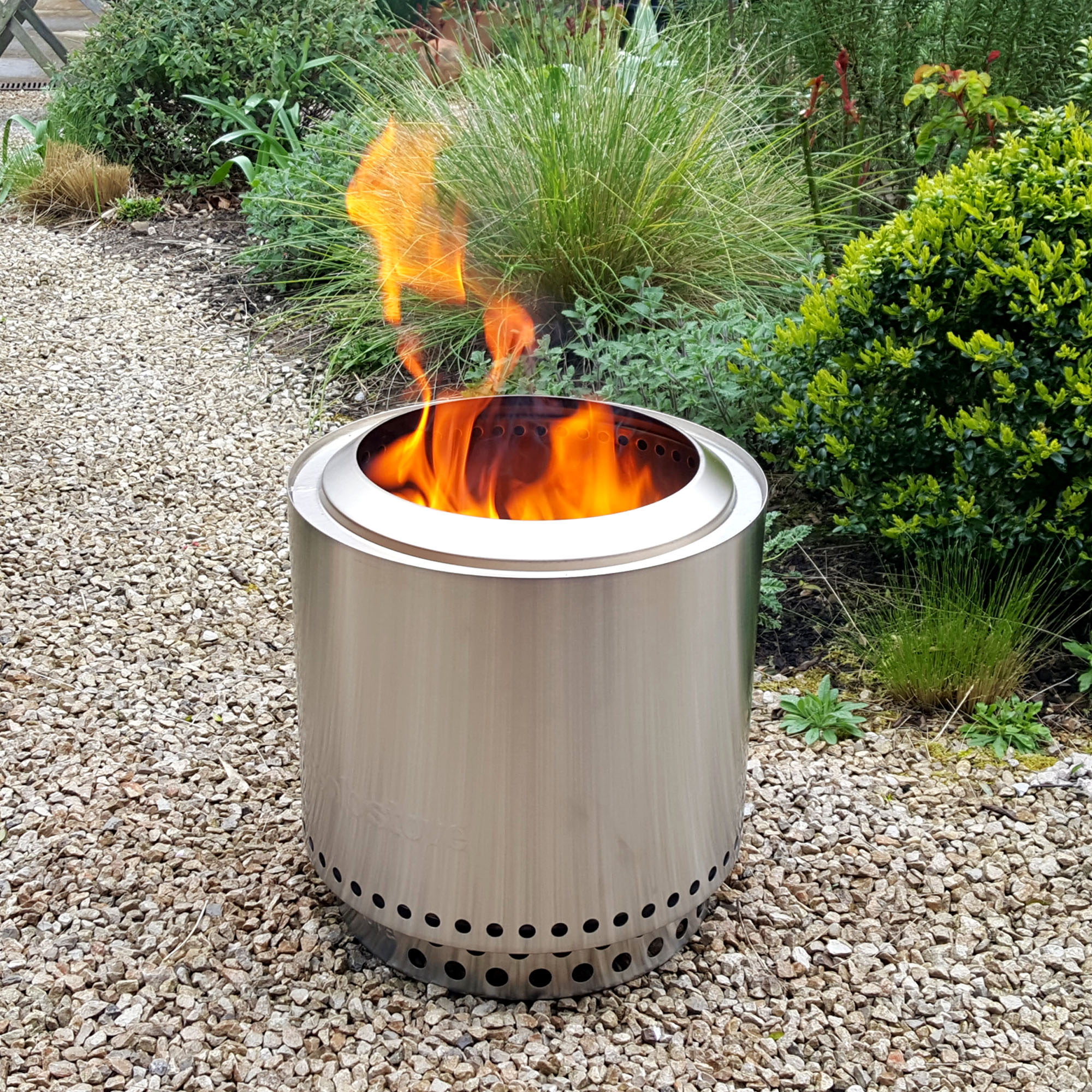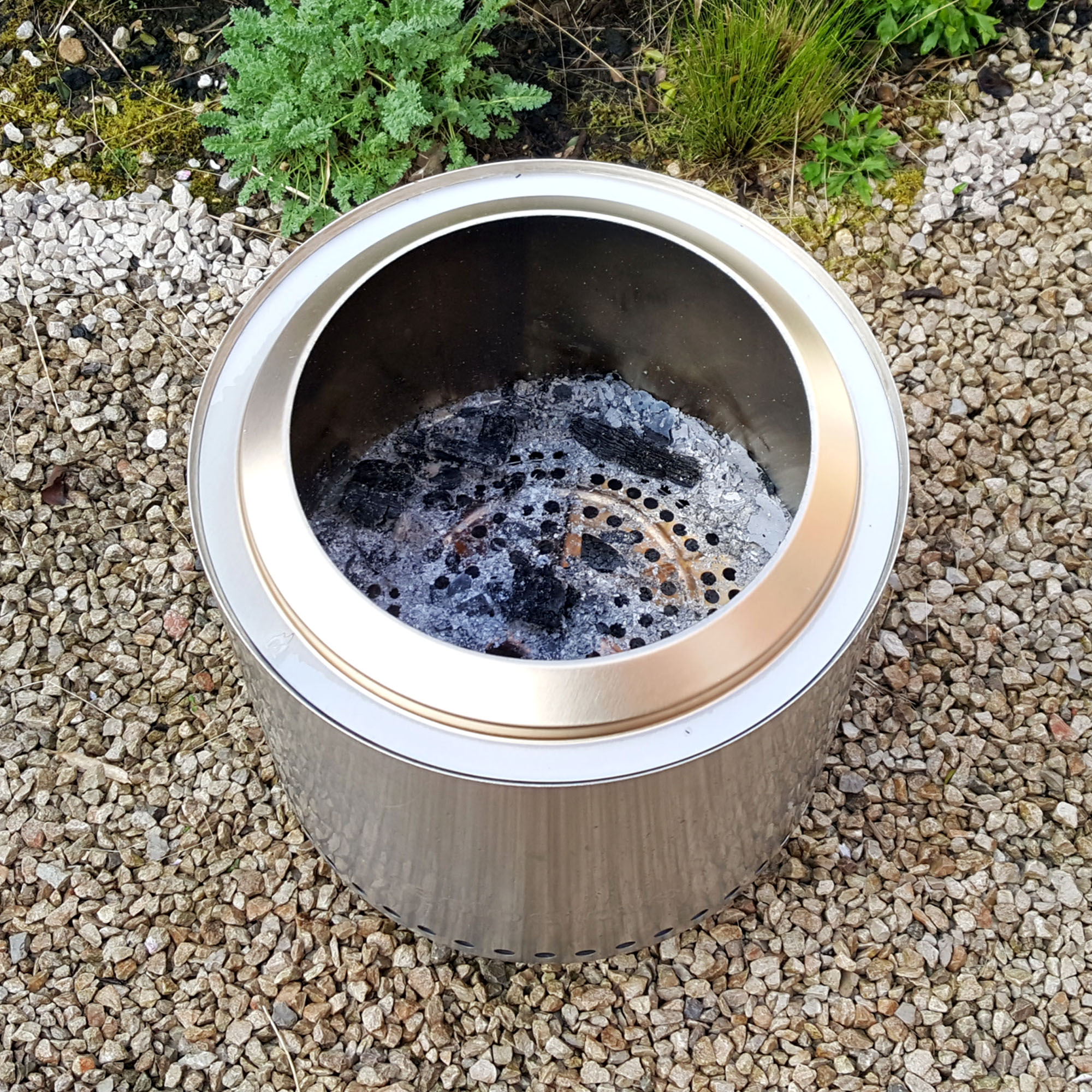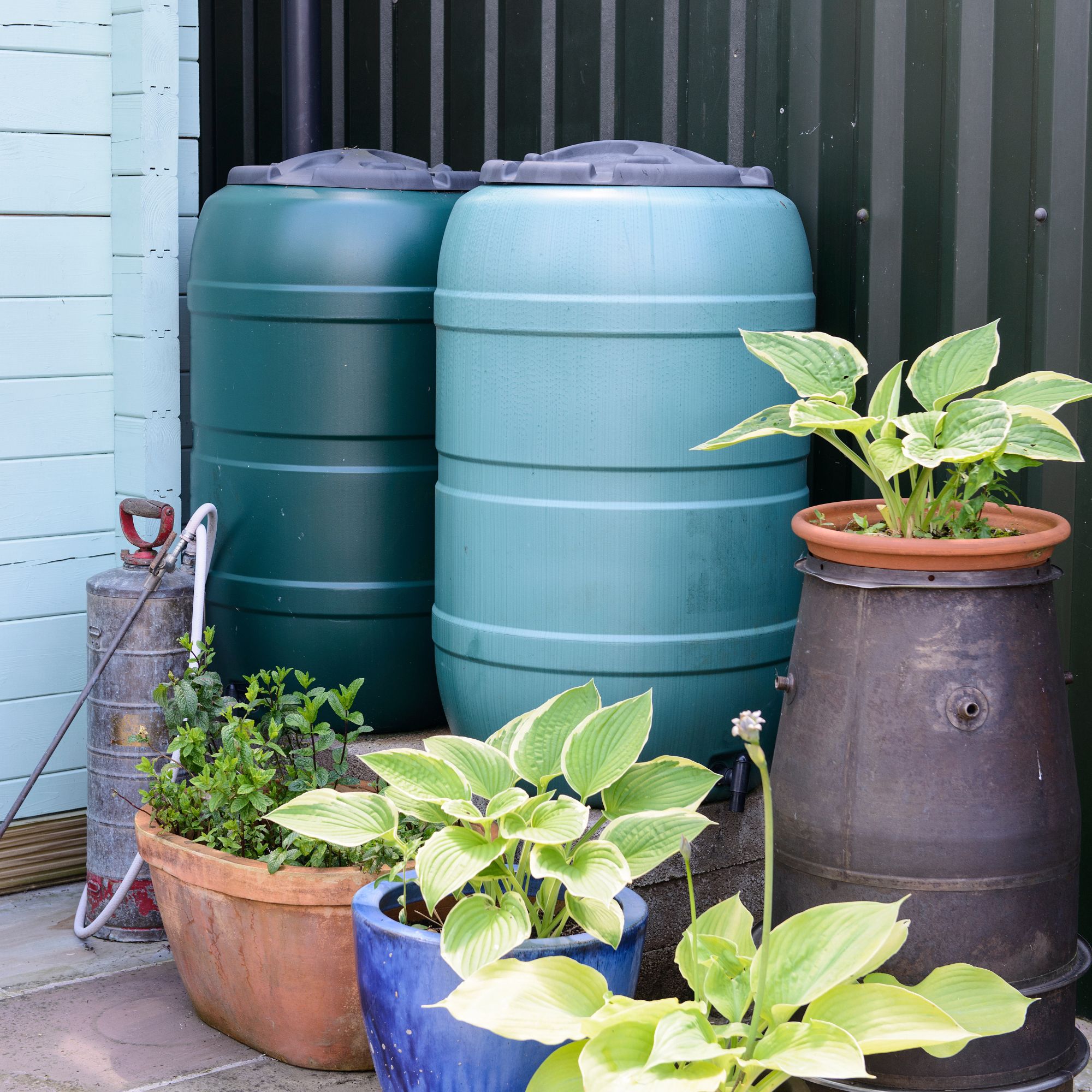‘Less smoke, more flame’ – why the Solo Stove Ranger is (almost) the perfect fire pit
Our Solo Stove Ranger Fire Pit review puts the brand's most affordable fire pit to the test and finds it really does offer less smoke and more flames

A stylish, easy-to-use, and easy-to-clean fire pit, that produces less smoke than most – there's a lot to love about the Solo Stove Ranger. The only downside? It's so fun to use that you'll soon want to invest in all of its accessories, and that could get expensive...
-
+
Less smoke than most fire pits
-
+
Good heat output
-
+
Stylish
-
+
Portable
-
+
Easy to use
-
+
Easy to clean
-
+
Wide range of accessories
-
-
An investment
-
-
Accessories are expensive
Why you can trust Ideal Home

Our Solo Stove Ranger Fire Pit review puts the brand's most affordable fire pit to the test to see if it can live up to its promise to deliver less smoke and more flames.
The Ranger fire pit is the smallest of the Solo Stove fire pit range, and therefore its most portable, with this fire pit touted as being brilliant for use in the backyard, as well as on camping trips.
Its 'less smoke' design is a very welcome selling point, as you'll know if you've ever spent an evening dodging billowing clouds of black smoke as you try to stay warm around a fire pit whilst the wind constantly changes direction.
However, despite coming in cheaper than the mid-sized Solo Stove Bonfire fire pit, and the brand's largest Yukon design, the Ranger is still quite the investment, so I was eager to see if its 'less smoke' design would prove true in practice, and how it would compare to some of the best fire pits on the market.
Solo Stove Ranger Fire Pit review
Specifications
- Fuel: Wood burning
- Size: H32cm x Dia.38cm
- Weight: 6.8kg
- Construction: 304 stainless steel


How I tested

I'm Amy, one of the Ideal Home team's Ecommerce Editors. My job involves putting all manner of outdoor products through their paces to find the best recommendations for our readers, from the best garden furniture to the best patio heaters. In this case that involved testing out the Solo Stove Ranger Fire Pit to see if it could live up to its smokeless claims. I tested the fire pit in early April in my parents' Shropshire-based garden, where the Ranger had cool winds to contend with as well as some welcome spring sunshine.
Assembly and set-up
Just like the larger Solo Stove Bonfire and Solo Stove Yukon fire pits, the Solo Stove Ranger fire pit can be purchased either on its own, or as part of several bundle options which include a variey of different accessories and add-ons.
I received the Solo Stove Ranger + Stand bundle, which includes the Ranger fire pit itself, a stand, and a carry case, all of which arrived packaged within one outer box.

On unboxing it was a shame to see that Solo Stove is still using non-biodegradable polystyrene packaging rather than a more eco-friendly alternative, but the inner packaging was fairly minimal at least.
The minute the Ranger is removed from the box, it's clear that this is a premium product. The stainless steel drum and accessories all feel very solidly constructed, and the fire pit itself gleams with only the slightest hint of sunshine falling on it.
Inside the box there's the fire pit itself, the ash pan, a base plate, the flame ring, the fire pit stand, and a black carry bag, as well as a couple of sheets of instructions for self-assembly.

Thankfully, the self-assembly required is very minimal. To assemble the fire pit all you need to do is position the removable ash pan in the bottom centre of the fire pit and then add the domed base plate on top.
If you want to use the stand – which is recommended on heat sensitive surfaces, like wooden decks – you simply lay the stand on a flat surface and then place the fire pit on top.

Performance
Once the fire pit is assembled, it's time to build your fire. Solo Stove recommends using dried and split hardwoods, and advises not overfilling the fire pit or covering the upper vent holes as this will decrease the fire pit's efficiency and create more smoke.
You just need to place your tinder, kindling and smaller wood pieces in the centre of the fire pit, light, and then add the flame ring onto the top of the fire pit with the angled edges pointing upward. This is designed to protect the flames from wind and create a more central burn.

As a fire lighting novice, I had some help getting the fire off to a good start from my Dad – as well as first dibs on the best pieces of wood from his wood pile – but we were both impressed by how easily the fire got going.
Solo Stove would likely say this is because the 'bottom vent holes allow oxygen to the feed the fire from below while simultaneously channeling warm oxygen up between the walls of the stove and back into the fire' and it certainly seemed like the extra ventilation was doing the trick.
Unlike a solid-based fire pit that can take a little longer to get going, the Ranger was soon burning well, with flames just beginning to show out the top of the fire pit after only five or so minutes.
At this point Solo Stove recommends gradually adding in enough wood to fill the burn chamber. However, we found it didn't need much fuel at all to produce a good amount of flame and enough heat to be felt when you were sitting a metre or so from the fire pit.

Once the fire is going, the flame ring funnels the flames into a mesmerising display, and between its gleaming stainless steel body and those rolling flames, the Ranger soon becomes quite the outdoor centrepiece.
So, the million dollar question... is the Solo Stove Ranger fire pit really smokeless? Well, not entirely in our tests. But definitely far less smokey than most fire pits. 'Less smoke' is more accurate than 'smokeless', although it did come close.
There were certainly no billowing clouds of black smoke encountered whilst using the Ranger. After we'd been stood around the fire pit for half an hour or so there was a faint smell of smoke on our clothes when we went indoors, but not to the extent you'd usually expect if you'd been stood around a bonfire or your average fire pit. There also wasn't any need for us to keep changing position when the wind changed direction to avoid the smoke, making this a much more enjoyable fire pit to use than your usual variety.
If you have a small patio and neighbours either side, this is one of the least intrusive fire pits I've used, and you won't be worrying about clouds of smoke blowing over the garden fence.
Solo Stove says this is down to the Ranger's 'double wall design which maximizes the airflow and burning process'. The brand states the 'bottom vent holes allow oxygen to the feed the fire from below while the double walls warm it, creating a burst of hot air over the fire reducing the smoke'.
However it works, in practice, the reduced smokiness was certainly welcome and allows the Ranger's flames to take centerstage.

Of course, to keep the fire going, you need to keep adding wood. This is where the flame ring – and the upright cylindrical design of the Ranger – does make things a little difficult as it can be tricky to drop in more wood without getting too close to the flames. You may need some tools to do this safely, and that's where things start getting more expensive.
The Ranger works perfectly well if you simply buy the fire pit alone – which is a significant investment in itself. But, when you come to use it, and especially if you enjoy using it and want to use it frequently – which I think you will – then you'll soon discover some additional accessories would be handy to increase ease of use and enjoyment.
Solo Stove has done a great job of listening to user feedback and added more and more accessories to its range for the Ranger, Bonfire, and Yukon fire pits. Whilst testing, whenever we encountered a practical problem where an accessory might have made things easier, checking the Solo Stove website revealed just such a Solo Stove fire pit accessory existed.

Need tongs to add on more logs without getting singed? You can buy those. Need a spark guard so you can ensure any pops and fire cracks are contained within the drum? You can buy one of those. Want a lid to protect the embers from blowing out of the drum whilst you're waiting for the fire to die down? You can buy one of those. Want a weather-proof cover so you can leave the fire pit outside, a carry handle, a heat deflector to spread the warmth sideways, or a surround to keep pets and little ones a safe distance from the flames... you get the picture.
You can now also buy accessories to help you cook on your Solo Stove fire pit, including a cast iron grill, griddle, and wok.
And you'll likely soon want a lot of those accessories, because this is a great piece of kit to use, and those accessories can make it even greater. However, on average, majority of those add-ons are around the £50-£100 mark, so the Solo Stove fire pit experience could soon become quite an expensive hobby.
That said, there are no doubt far worse ways to spend your money. And if you want to get stuck into enjoying the great outdoors in style, this is a great way to do so. If you're buying the Solo Stove Ranger as a gift, it may also be a bonus to know that you'll have plenty of add-ons to gift for the recipient's next five year's worth of Christmas and birthday presents!

Cleaning
The design of the Solo Stove fire pit promises a more efficient burn. Solo Stove says 'a more complete burn means the little particles that would have been smoke are burned up by the top vents. It also means no more half burned logs to deal with', and this is certainly what we found in practice.
We let the embers burn down and soon all that was left was a few small chunks of charcoal and grey ash in the pan.
Once everything is throughly cool, Solo Stove advises brushing the embers through the holes in the base plate so they collect in the ash pan underneath. This was very easy to do, and two slightly bigger holes in the base plate also allowed the small chunks of charcoal remaining to be brushed through into the ash pan.

Unlike many fire pits where you need to turn the entire fire pit upside down to get rid of the ash, thanks to the removable ash pan, this process was very low-effort with the Solo Stove. Once you've brushed all the ash off the base plate you can simply lift it out, and then lift out the ash pan.
All in all, cleaning the Solo Stove Ranger after use was a very neat and tidy process. Although admittedly we hadn't burnt a lot of wood during the Ranger's inaugural lighting. If we had burnt more wood then perhaps the ash would have overflowed the ash pan a little more.
As it was, I did turn the main body of the fire pit over to empty out the last few dregs of escaped ash, but largely the ash collected neatly in the ash pan for safe and easy disposal.

Handily, once the fire pit is emptied of ash and given a little wipe down, all of the accessories – including the flame ring and base stand – fit neatly inside the fire pit drum for space-saving storage.
Overall, both set-up, use, and cleaning of the Ranger was super easy, and although it's hard to clean up charcoal and ash without getting a little dirty, it was still a relatively mess-free experience.

Portability
The Ranger is Solo Stove's most portable fire pit, however, it's still fairly heavy, weighing in at 6.8kg.
Its cyclindrical design is also a little awkward to carry, although the dedicated Solo Stove Ranger carry handle (available to purchase separately or as part of the Ranger Ultimate Bundle) does look like it would make manoeuvring the fire pit around in the garden a lot easier.
However, if you want to take the Ranger on more exciting excursions than just to the bottom of the garden, it also comes equipped with a sturdy carry bag that you can use to take it camping, or simply for storage in the garage or shed.
I personally wouldn't want to be carrying the Ranger that far, as it's still a decent weight. But, its compact, upright design is definitely easier to fit in the car and lug about than a typical bowl-shaped fire pit. And, the fact that pretty much all of the Ranger fire pit's accessories can be stored inside the fire pit drum makes it even more portable.

FAQs
Do Solo fire pits really work?
When I tested the Solo Stove Ranger fire pit, I was definitely impressed by its performance. Whilst I wouldn't say it was entirely smokeless when I put it through its paces, there was certainly far less smoke than you'd experience with a normal fire pit.
Can Solo Stoves be left outside?
Solo Stove says that it's important to keep rain and snow out of your fire pit, so it's not recommended to leave any of the brand's fire pits outside uncovered when not in use.
That said, you can buy a weather-resistant PVC-coated polyester Solo Stove Shelter cover for use over your fire pit that the brand says will protect it from 'heavy winds, excessive moisture, and extreme heat'. That means you can then store the fire pit outside. However, the brand does still advise that if your fire pit isn’t in use for several months it should be 'moved to a covered area such as a garage or covered patio' for extra protection from the elements.
As the brand says, 'stainless steel has an increased resistance to rust, but it is not rust-proof', so protecting your fire pit from prolonged exposure to moisture will reduce the possibility of rust or discolouration.

Verdict
All in all, I loved using the Solo Stove Ranger Fire Pit. It's easy to assemble, easy to get burning, looks super stylish, produces mesmerising flame action that dishes out a decent amount of heat for four to sit around, and it's very easy to clean once your fire is burnt out.
And, whilst I personally wouldn't want to carry it very far, it is portable, and its basic accessories pack away neatly inside the drum for space-saving storage when it's not in use.
Plus, although not entirely smokeless in our tests, it definitely produces a lot less smoke than your average fire pit. That means you won't come inside reeking of bonfire smoke after a few hours warming your hands around its glowing embers, and if you live in a built-up area, your neighbours aren't likely to be as inconvenienced by smoke billowing over the garden fence.
The only real downside I came across is its price tag. The Ranger is Solo Stove's entry-level fire pit, but it's still an investment. At full RRP it's easily three times the price of your average fire pit, and, whilst I do think it's worth that for its multiple merits, if you enjoy using it – which you will – you're probably soon going to want to invest in some accessories, and that's where things can start to get expensive.
However, as long as you have the budget to play with, then this is a great fire pit that offers a wealth of add-ons to tailor your outdoor fire-making experience to your liking.
If you want a larger fire pit, then it's well worth checking out our Solo Stove Bonfire review. This wider design offers all of the same attributes as the Ranger but creates more heat, so you warm roughly eight people around its flames. However, if you have a small garden or you're after a portable fire pit, then the Solo Stove Ranger would definitely be my first choice. And when you do come to invest in some accessories, as the smaller design, the Ranger's accessories are the more affordable.
Get the Ideal Home Newsletter
Sign up to our newsletter for style and decor inspiration, house makeovers, project advice and more.

Amy is Ideal Home’s Sleep Editor and the Ideal Home Certified Expert on Sleep. She's spent the last four years researching and writing about what makes for the best night’s sleep during the day and testing out sleep products to find the best-in-class by night. So far she’s clocked up over 10,000 hours of pillow, duvet, and mattress testing experience.
Our go-to for all things sleep-related, she’s slept on and under bestselling products from Simba, Emma, Hypnos, Tempur, Silentnight, Panda, and many many more.
As a hot sleeper, Amy is always on the lookout for the most breathable bedding, but she also leads a wider team of testers to ensure our product testing encompasses both hot sleepers, cold sleepers, front sleepers, back sleepers, side sleepers, and everything in-between.
-
 I spent the afternoon looking through Wayfair's garden sale – these are the 6 pieces I'm buying immediately for summer
I spent the afternoon looking through Wayfair's garden sale – these are the 6 pieces I'm buying immediately for summerThese are my must-have garden buys from the sale
By Holly Reaney
-
 I’ve found the perfect alternative to John Lewis’ sold-out striped garden chair – and you won’t believe where it's from
I’ve found the perfect alternative to John Lewis’ sold-out striped garden chair – and you won’t believe where it's fromJohn Lewis' Sling Garden Chair is one of the most stylish pieces of garden furniture I'd seen – until I tracked down this QVC lounge chair...
By Kezia Reynolds
-
 Experts warn gardeners not to neglect this important task this weekend – how to get it right to help your plants survive the warm spring weather
Experts warn gardeners not to neglect this important task this weekend – how to get it right to help your plants survive the warm spring weatherSome experts are calling it a mini spring drought
By Sophie King